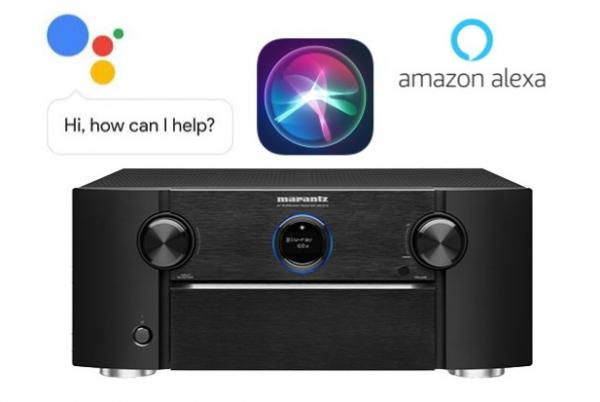Comparing a modern AVR to what was considered a Hi-Fi receiver in the 1950's is a stretch. Perhaps "1960's" tech is more apropos, since thats when solid-state stereo receivers (with, at the very least, similar dimensions to modern AVRs) began to proliferate.
How 1950s Tech Is Making Amazon, Google, and Apple Play Nice Together

Voice technology is pervading our daily lives in a big way. According to insights from a Nielsen Research survey, at the end of June 2018 24% of U.S. homes owned a smart speaker. If my shoddy math is correct, that’s about 31.5 million smart devices (25% of 126 million homes).
That’s a lot of homes enabled with a key to voice-assistant bliss. So why aren’t we barking orders at our appliances more regularly?
Well, several reasons. For one, there are too many choices and people dread having to deal with compatibility problems between devices and systems, which leaves them wandering through the proverbial voice void where supremacy battles rage on between major players like Amazon, Google, and Apple. Alexa doesn’t play nice with Google Assistant, which doesn’t play nice with Siri, and so on. This makes it difficult for people to buy smart-home products because some products work with Google and others with Siri or Alexa.
So, what’s a voice-assistant-hopeful to do?
You might be surprised to learn that a product conceived in the 1950s is helping voice assistants play nice in 2018. That product is the stereo receiver, which evolved into the Audio Video Receiver (AVR) when Dolby Stereo was adapted for use at home in the 1980s, first as Dolby Surround Sound and later as Dolby Pro Logic. The modern AVR consolidates all of the latest audio and video technologies — from three-dimensional audio formats like Dolby Atmos to wireless multiroom capability to advanced video codecs and much more — into one component.
The goal, of course, is to provide easy access to all of this remarkable technology. So it should come as no surprise that companies like Denon and Marantz that specialize in these advanced pieces of equipment would explore how to integrate voice control technologies into an AVR.
Ultimately, people want home technology to work seamlessly — especially when it comes to entertainment. Whether we own an Alexa- or Google Assistant-based speaker/device or a Siri-enabled iPhone, we want to be able to say “play music” and enjoy our favorite tunes without having to worry about choosing the right ecosystem. We want flexibility. Problem is, the voice-assistant industry is too fragmented to offer a meaningful solution.
That’s why the AVR is such a perfect fit for people who are interested in using voice assistants at home. The modern AVR makes everything work together — and that’s the magic people crave.
In case you’re wondering, Denon and Marantz are the only AVR brands that support all three voice assistants, along with the voice-controlled home automation system Josh.ai. Which means, if you have multiple voice assistants at home and want them to work with any degree of harmony, you’ll need a Denon or Marantz receiver to make that happen.
But there is still work to be done. Right now voice support for AVRs is limited to what has been made available by Google, Amazon, and Apple. And while using spoken commands to play music is a beautiful thing, the ultimate goal is for the AVR to facilitate a truly unified experience that replicates what you can do with a remote control or app. In other words, when you tell the voice assistant to “play movie X from Amazon Prime,” the AVR turns on all of your gear, establishes the proper audio/video settings, dims the lights, and starts the movie. The AVR becomes the brain for the whole home.
Where Do We Go From Here?
The beauty of implementing voice technology via an AV receiver is that companies like Denon and Marantz are brand agnostic and able to partner with an array of technology providers for limitless possibilities.
In the future, voice control will become the norm and artificial intelligence (AI) will make control decisions and activate settings based on past use and/or a specific person in the room. Over time, we will see better voice integration with all kinds of home systems as well as contextual awareness that provides an understanding of who’s home and what that individual might want to do.
Okay, we’re starting to enter the realm of speculation, which is fun but ultimately just a guess, so I turned to Yoshinori Yamada, technical category leader for AVRs at Sound United, for his take on what's next in voice control. Yamada believes the future will be one of fewer physical interactions:
“I enjoy thinking about what the future of entertainment looks like, though it can be a dangerous game to play with any degree of certainty given how quickly technology changes. But I imagine screens will matter less and less in the future as they give way to three-dimensional virtual experiences around the home. I also think machine learning will continue moving on a path toward true personalization.”
Yamada also sees a day when voice-enabled technologies are overtaken by mind-enabled technologies. “I believe we will see a day in the not-so-distant future where thoughts can be transmitted wirelessly to a separate device for decoding. This will be a true point of singularity with our electronic devices and something to be really excited about.”
As we move into the future, Yamada believes cross-industry collaborations with the world’s largest technology companies will enable the AV receiver to continue playing a pivotal role in how humans interact with technology, just as it has for the past few decades. I think that’s something we can all greatly look forward to.
- Log in or register to post comments






























































